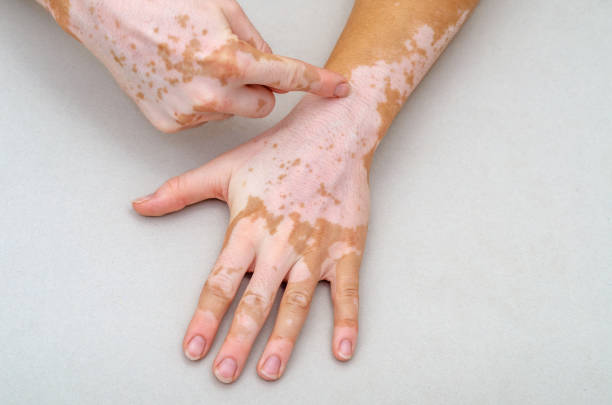Understanding Vitiligo: Vitiligo Treatment in Ayurveda for Skin Restoration

Vitiligo is a skin condition that causes the skin to lose its natural pigmentation, resulting in white patches. It can appear anywhere on the body and is often more noticeable in individuals with darker skin. The condition occurs when melanocytes, the cells responsible for producing melanin, are destroyed or damaged. Vitiligo can affect people of all ages and ethnic backgrounds. While the exact cause is still not fully understood, autoimmune disorders, genetic factors, and environmental triggers are believed to play a role. The impact of vitiligo goes beyond the skin, as it can affect an individual’s self-esteem and mental health.
While conventional treatments for vitiligo, such as corticosteroids and light therapy, are available, many people are turning to more natural solutions, such as vitiligo treatment in Ayurveda, for skin restoration. Ayurveda, an ancient Indian system of medicine, offers a holistic approach to treating vitiligo, focusing on restoring balance within the body to promote healing and skin regeneration. In this blog, we will explore the science of vitiligo, how vitiligo treatment in Ayurveda works, and its potential for skin restoration.
What is Vitiligo?
Vitiligo is a condition where the skin loses its pigment, leading to the formation of white patches. The patches can appear anywhere on the body, including the face, hands, and private areas, and may grow in size or spread to other parts of the body over time. The loss of pigment occurs when melanocytes, the cells that produce melanin (the pigment responsible for skin color), are destroyed or fail to function properly.
There are two main types of vitiligo:
- Non-segmental vitiligo (generalized vitiligo): This is the most common form of vitiligo, characterized by patches of depigmentation that appear symmetrically on both sides of the body.
- Segmental vitiligo: This type affects one side of the body and tends to progress more slowly than non-segmental vitiligo.
Although vitiligo is not contagious or life-threatening, it can be emotionally distressing for individuals who experience it. Many people with vitiligo seek treatment to restore their skin’s natural color and improve their self-confidence.
What Causes Vitiligo?
While the exact cause of vitiligo remains unclear, several factors are believed to contribute to the development of the condition:
- Autoimmune response: In many cases, vitiligo is considered an autoimmune disorder. This means that the body’s immune system mistakenly attacks its own melanocytes, leading to their destruction.
- Genetic factors: Vitiligo can run in families, suggesting that genetic factors may play a role in its development.
- Environmental triggers: Stress, skin injuries, and certain chemicals or medications are believed to trigger or worsen vitiligo in susceptible individuals.
The cause of vitiligo is multifactorial, involving both genetic and environmental factors, and while there is no cure for the condition, treatments are available to manage symptoms and restore skin pigmentation.
How Does Vitiligo Treatment in Ayurveda Work?
Ayurveda is an ancient system of medicine that aims to restore balance to the body, mind, and spirit. According to Ayurveda, health is a result of the balance of three doshas—Vata, Pitta, and Kapha—within the body. When these doshas are out of balance, it leads to disease. Vitiligo is believed to be a result of an imbalance in the Pitta dosha, which governs skin, color, and pigment.
Vitiligo treatment in Ayurveda works by addressing the root causes of the condition, aiming to restore balance and promote healing from within. Ayurveda emphasizes the use of natural remedies, herbs, dietary changes, lifestyle adjustments, and therapies to support skin regeneration and immune function.
1. Herbal Remedies for Vitiligo Treatment in Ayurveda
Ayurvedic herbs play a key role in the treatment of vitiligo. These herbs are known for their healing properties, helping to restore pigment, improve skin health, and balance the doshas. Some commonly used herbs in vitiligo treatment in Ayurveda include:
- Bakuchi (Psoralea corylifolia): This herb is widely used in Ayurvedic medicine for treating vitiligo. It is believed to stimulate the production of melanin, the pigment responsible for skin color. Bakuchi is often used topically as oil or paste and is also used internally in powdered form to treat vitiligo.
- Bhringraj (Eclipta alba): Known for its ability to promote healthy skin, Bhringraj helps rejuvenate melanocytes, the pigment-producing cells in the skin. It is commonly used in oils, powders, or as part of Ayurvedic skin formulations.
- Turmeric (Curcuma longa): Turmeric is known for its anti-inflammatory and antioxidant properties. It helps in reducing oxidative stress, a factor that contributes to the destruction of melanocytes in vitiligo.
- Ginger (Zingiber officinale): Ginger has potent anti-inflammatory properties that can help reduce skin irritation and inflammation associated with vitiligo. It can also support the detoxification process in the body.
- Haritaki (Terminalia chebula): Haritaki is known for its ability to detoxify the body, which is crucial for managing vitiligo, as toxins can contribute to the condition.
These herbs are often used in combination with other Ayurvedic treatments to restore skin health and promote the regeneration of pigment.
2. Panchakarma Therapy for Vitiligo Treatment
Panchakarma is a detoxification process in Ayurveda designed to cleanse the body of toxins (ama) that can cause disease. It involves five therapeutic treatments:
- Vamana (Emesis therapy): Induces vomiting to eliminate toxins from the digestive system.
- Virechana (Purgation therapy): Uses herbal laxatives to cleanse the gastrointestinal system.
- Basti (Enema therapy): Removes toxins from the colon.
- Raktamokshana (Bloodletting): Cleanses the blood to remove impurities.
- Nasya (Nasal administration of medicines): Clears the sinuses and head region of toxins.
Panchakarma is considered an essential part of vitiligo treatment in Ayurveda, as it helps detoxify the body, strengthen the immune system, and promote skin restoration.
3. Dietary Changes for Vitiligo Treatment
In Ayurveda, diet plays a vital role in maintaining health and promoting healing. For vitiligo, Ayurvedic practitioners recommend a balanced, nutrient-rich diet to support the body’s ability to regenerate skin pigment. Some dietary tips for managing vitiligo include:
- Include copper-rich foods: Foods like sesame seeds, cashews, and almonds are rich in copper, which is essential for melanin production.
- Increase antioxidants: Foods rich in antioxidants, such as fruits, vegetables, and nuts, help fight oxidative stress, which can damage melanocytes.
- Avoid processed foods: Processed foods and fried items can increase inflammation in the body, which may worsen vitiligo symptoms.
- Focus on cooling foods: Ayurveda recommends cooling foods like cucumbers, melons, and leafy greens to balance the Pitta dosha and soothe the skin.
A healthy diet tailored to the individual’s dosha can help restore balance and improve the skin’s ability to regenerate pigmentation.
4. Lifestyle Adjustments for Vitiligo Treatment
Along with herbal remedies and dietary changes, Ayurveda emphasizes the importance of lifestyle adjustments to support overall well-being and skin health. Some Ayurvedic lifestyle practices for managing vitiligo include:
- Stress management: Stress can trigger or worsen vitiligo, so incorporating stress-reduction techniques like yoga, meditation, and deep breathing exercises can be beneficial.
- Adequate sleep: Ensuring a good night’s sleep helps the body regenerate and heal. Ayurveda recommends at least 7-8 hours of restful sleep each night.
- Moderate sun exposure: Ayurveda suggests limited sun exposure, as sunlight can stimulate melanin production in the skin. However, excessive sun exposure can harm the skin, so moderation is key.
Benefits of Vitiligo Treatment in Ayurveda
- Natural and safe: Ayurvedic treatments are based on natural herbs and remedies, making them safe with minimal side effects.
- Holistic approach: Ayurveda treats the root causes of vitiligo by focusing on detoxification, immune system support, and overall health.
- Customized treatment plans: Ayurveda tailors treatments based on an individual’s unique constitution, ensuring personalized care.
- Supports long-term healing: Ayurvedic treatments promote long-term healing by balancing the body’s systems and boosting overall health.
Effectiveness of Vitiligo Treatment in Ayurveda
The effectiveness of vitiligo treatment in Ayurveda varies from person to person. While some individuals experience significant improvements in skin pigmentation, others may notice gradual changes. It is important to understand that Ayurveda takes time to show results, as it works by restoring internal balance and promoting overall skin health.
Consistency with treatment, a balanced lifestyle, and a healthy diet are essential for achieving the best results. Ayurveda can be a powerful complement to other medical treatments, but it is recommended to consult with an experienced Ayurvedic practitioner for a personalized treatment plan.
Conclusion
Vitiligo treatment in Ayurveda offers a natural, holistic approach to managing and treating vitiligo. By focusing on restoring balance within the body through herbal remedies, Panchakarma therapy, dietary adjustments, and lifestyle changes, Ayurveda provides a safe and effective solution for skin restoration. While the effectiveness of Ayurvedic treatment may vary, many individuals have found relief from vitiligo through this ancient healing system.
If you’re looking for a natural and holistic way to manage vitiligo, consult with an Ayurvedic practitioner to create a personalized treatment plan tailored to your needs.



